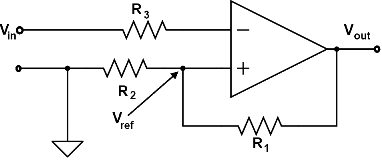Comparators
A comparator is a device which is used to sense when an arbitrary varying signal reaches some threshold or reference level. Comparators find application in many electronics systems: for example, they may be used to sense when a linear ramp reaches some defined voltage level, or to indicate whether or not a pulse has an amplitude greater than a particular value. Provided that suitable output limiting is provided, comparator outputs may be used to drive logic circuits.
The Schmitt trigger is an important switching circuit that is widely used in digital systems. Its stable state is determined by the amplitude of the input voltage. For a given circuit two finite values of input voltages, called the upper trip point (UTP) and the lower trip point (LTP), cause the circuit to switch from one stable state to the another. Thus the circuit may be used to discriminate between two D.C. voltage levels: in this capacity it is known as a comparator.
Diode Comparator
The non-linear circuits to perform the operation of clipping may also be used to perform the operation of comparison. The basic difference between the two is that in comparator there is no interest in reproducing any part of the signal waveform. For example, the comparator output may consist of an abrupt departure from source quiescent level which occurs at the time the signal attains the reference level but is otherwise independent of the signal. Or the comparator output may be a sharp pulse which occurs when signal and reference are equal.
If we assume that ramp signal is applied to the input, as shown in Figure 1(a) the output Figure 1(b) is constant VR volts until the ramp signal reduces a value equal to VR volts until the ramp signal reduces a value equal to VR volts then the diode conducts and the input signal appears at the output.
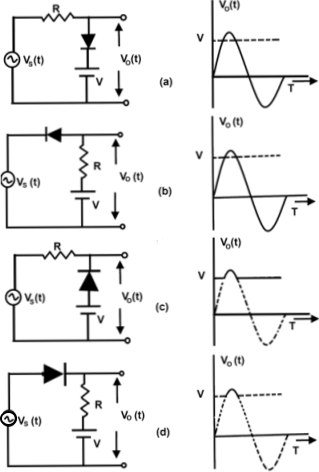
In a circuit a clipper was important that the portion of the wave form passed by the diode was not distorted. The exact time t1 at which the diode began conducting was of secondary importance. Now this circuit will be considered as a voltage comparator, (since it compares the varying signal voltage with the reference voltage and hence the name voltage comparator) and of primary concern is the time at which the input signal voltage reaches the reference level VR. The shape of the output waveform is of secondary importance. A diode used for this purpose called pick-off diode. Similarly with an increasing ramp at its input the circuit of Figure 1(c) will be continue to operate as a comparator. Its response will be same as shown in Figure 2(b). The diode of this circuit is then referred to as a breakaway diode. The other two circuits shown in Figure 1 (a) and (b) will act as comparators with a decreasing ramp. Their response is shown in Figure 2 (c) and (d).
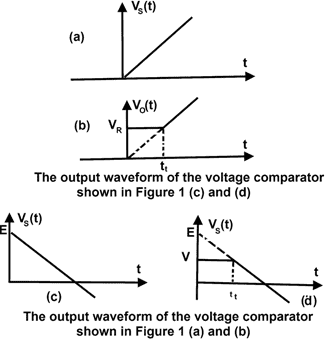
Transistor Comparator
The basic differential amplifier circuit using bipolar transistor shown in Figure 3 acts as a voltage comparator circuit, where Vo (t) is the input signal to be compared with a reference voltage V. For good results, it is necessary that the transistors Q1 and Q2 as will as resistors RC1 and RC2 are well matched. The circuit will offer an excellent CMRR (defined as the ratio of common mode input voltage change and equivalent differential input voltage), high voltage gain and optimum output stability with respct to device when (i) RE is large (>re of Q1, Q2) and (ii) outputs is taken differentially. The former requirement is usually met with by employing a constant current source (IE) in the common emitter path of Q1 and Q2.
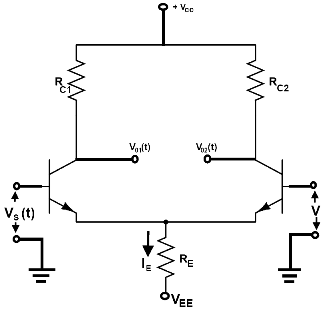
Voltage comparators following the differential amplifier approach can be easily designed to posses CMRR of 40-60 dB. This is helpful in increasing the range over which the two input voltages are equal.
IC Voltage Comparator
Comparator type circuits are used where it is desired to determine if an unknown analog voltage equals or exceeds a known reference voltage. In addition, the comparison can be used to convert sine wave and trigger pulses into square waves and thereby serves a pulse generator.
The comparator makes use of an operational amplifier whose output can be fed back to the non-inverting (positive) input in order to provide "snap action" in the output switching. When an operational amplifier is provided whit a reference voltage at one input and trigger or comparing voltage at its other input, the output of the amplifier will rest at either cut-off or saturation. If the amplifier is supplied with ±15V(Vcc), the output will be either plus or minus 15V, depending on the polarity of the trigger voltage compared to the reference voltage.
Figure 4 shows an inverting voltage comparator. The non-inverting input is provided with the reference voltage, and the inverting input is fed with a signal voltage to be compared with the reference. Since the input is to the inverting terminal, the signal voltage will result in an output pulse of opposite polarity. The input voltage must be greater than the reference voltage before the comparator will change its state. There is no upper positive limit so long as the input resistor limits the current to 200 µA or less (depending on the parameters of the operational amplifier used.)
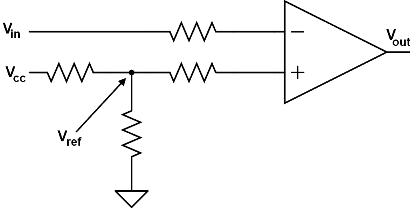
The output of the amplifier can be made to change states quickly (snap action) if positive feedback is provided, as in Figure 5. The input to the amplifier at the inverting terminal and hence the comparator is of the inverting type. In addition the feedback network here provides the reference voltage. The reference voltage developed across R2 is determined as follows:
Vref = (R2 / (R1 + R2)) Vout
where Vout can be either positive or negative. The input signal polarity needed for switching to occur depends on the resting state of the output.
